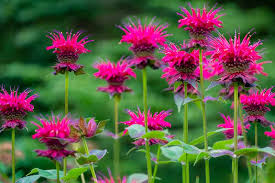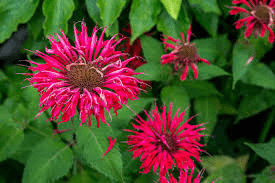With the name Bee balm, this ornamental flower attracts not only bees, but hummingbirds and other beneficial pollinators. Bee balms are highly valued for their deep scarlet color, but also come in blue, violet, white and pink.
Sun Needs: Full Sun / Partial Shade
Soil Needs: Damp
Zones: 4 – 9
Height: 2 – 4 feet
Blooms in: Mid‑Summer – Late Summer
Features: Attracts bees, butterflies
A perennial favorite native to North America, bee balm (also called wild bergamot) is beloved in flower beds for its beautiful blooms of red, pink, purple or white not to mention the fragrant foliage.

Also known by its botanical name of Monarda, bee balm is very attractive to bees, butterflies and hummingbirds. The bee balm flower has an open, daisy-like shape, with tubular petals in shades of red, pink, purple and white. Bee balm plants are perennial, coming back year after year to add cheerful color to your garden.
Bee balm (Monarda), is also known as Oswego tea, horsemint, and bergamot. It’s a member of the mint family (Lamiaceae) and a versatile perennial plant.
The plant attracts pollinators, and is a good addition to homemade potpourris and lotions.
Bee balm flowers are so captivating that they add color and beauty to any garden.
Here’s how to plant and grow bee balm in your garden!
Planting Bee Balm Flowers

Bee balm plants prefer moist, rich soil, and a sunny location. Bee balm will tolerate shade, particularly in hot-summer areas. Plant it in any protected spot that would benefit from a bright shot of color.
Most varieties of the bee balm plant are between 2 1/2 feet to 4 feet (76 cm. – 1 m.) tall, but there are also dwarf varieties less than 10 inches (25 cm.) high. Dwarf varieties are excellent for container gardens or up front in your flower border where you can appreciate the shaggy, tubular blooms of the bee balm flower.
How to Plant Bee Balm
- Bee balm can be planted in the spring or in the fall.
- Bee balm thrives in full sunshine. It can be grown in partial sun, but it won’t bloom as happily as it does in full sun.
- Given its height (2-4 feet), bee balm makes for an excellent background plant in a pollinator garden.
- Space plants 18-24 inches apart in rich, well-draining soil.
- Bee balm needs good air circulation, otherwise it can develop powdery mildew on its leaves.
- Water thoroughly at the time of planting.
Care

How to Grow Bee Balm
- Keep soil evenly moist through the growing season.
- Add mulch around the plants to preserve the moisture in the soil and control weeds.
- Deadhead faded blooms to encourage the plant to re-bloom in late summer.
- After the first frost in the fall, cut stems back to about 2 inches above the soil.
- Divide bee balm every 2 to 3 years to ensure its vigor. In the spring make small divisions of the newer roots of established plants and replant.
Pests/Diseases
- Powdery mildew: Powdery mildew commonly occurs on the foliage of bee balm if humidity is too high. Reduce watering if this is the case.
Recommended Varieties
- Monarda didyma is bright red and grows 3 to 4 feet tall.
- M. fistulosa produces lavender-pink blooms in late summer.
- M. pringlei grows 18 inches tall and is immune to powdery mildew. ‘Petite Wonder’ and ‘Petite Delight’ are pink varieties.
- Other powdery mildew resistant bee balm varieties include ‘Marshall’s Delight’ (bright pink), ‘Jacob Cline’ (deep red), and ‘Raspberry Wine’ (dark red).
Wit & Wisdom
- Native Americans and early colonists used bee balm leaves and flowers to make a variety of medicinal salves and drinks.
- Bee balm is a member of the mint family (Lamiaceae). Its foliage has a strong aroma and is sometimes used in herbal teas, salads, and as garnishes. The flowers are also edible.
- Despite being called “wild bergamot,” bee balm is not used in “bergamot” tea (a.k.a. Earl Grey tea). The tea is made with oils extracted from the rind of the bergamot orange, a citrus fruit.
Read Also: Astilbe Flowers – All you need to know
Quick Guide to Growing Bee Balm
- Plant bee balm in spring or fall, once all chances of frost have passed.
- Space bee balm plants 18 to 24 inches apart in an area with full sun and fertile, well-drained soil with a pH of 6.0 to 6.7.
- Improve native soil by mixing in several inches of aged compost or other rich organic matter.
- Bee balm can withstand a dry spell, but for best results, water whenever the top inch of soil becomes dry.
- Encourage big, beautiful blooms by feeding bee balm with a water-soluble plant food.
- Flowers can be enjoyed as decorations or as a gorgeous garnish in salads and desserts.
Soil, Planting, and Care
For prolific blooms, plant in full sun; in the South and Southwest, a little afternoon shade helps flowers last longer. Picking the flowers encourages a second round of blooms. For best results, start with strong, vigorous young bee balm plants from Bonnie Plants®, the company that has been helping home gardeners find success for over a century.
Space plants 18 to 24 inches apart in rich, well-drained soil with a pH from 6.0 to 6.7. Improve your native soil by mixing in a few inches of compost or aged compost-enriched before planting.
In addition to starting with great soil, you’ll want to feed your bee balm to produce excellent growth. Apply a liquid fertilizer every week throughout the growing season to feed the soil as well as your plants.
Although it will tolerate drought, bee balm will do much better if it gets adequate moisture; however, protect it from poor drainage, especially in winter. Water when leaves wilt in dry weather. Mulch in the spring.
In the late fall, cut plants back to within several inches of the ground. For a bushier shrub, pinch the tips of the stems when new growth appears each spring.
Bee balm spreads but not as aggressively as other members of the mint family. Every 3 or 4 years, dig up and divide the plants. Discard the old center section and replant the outer roots and shoots.
Frequently Asked Questions
We will update this section soon.
